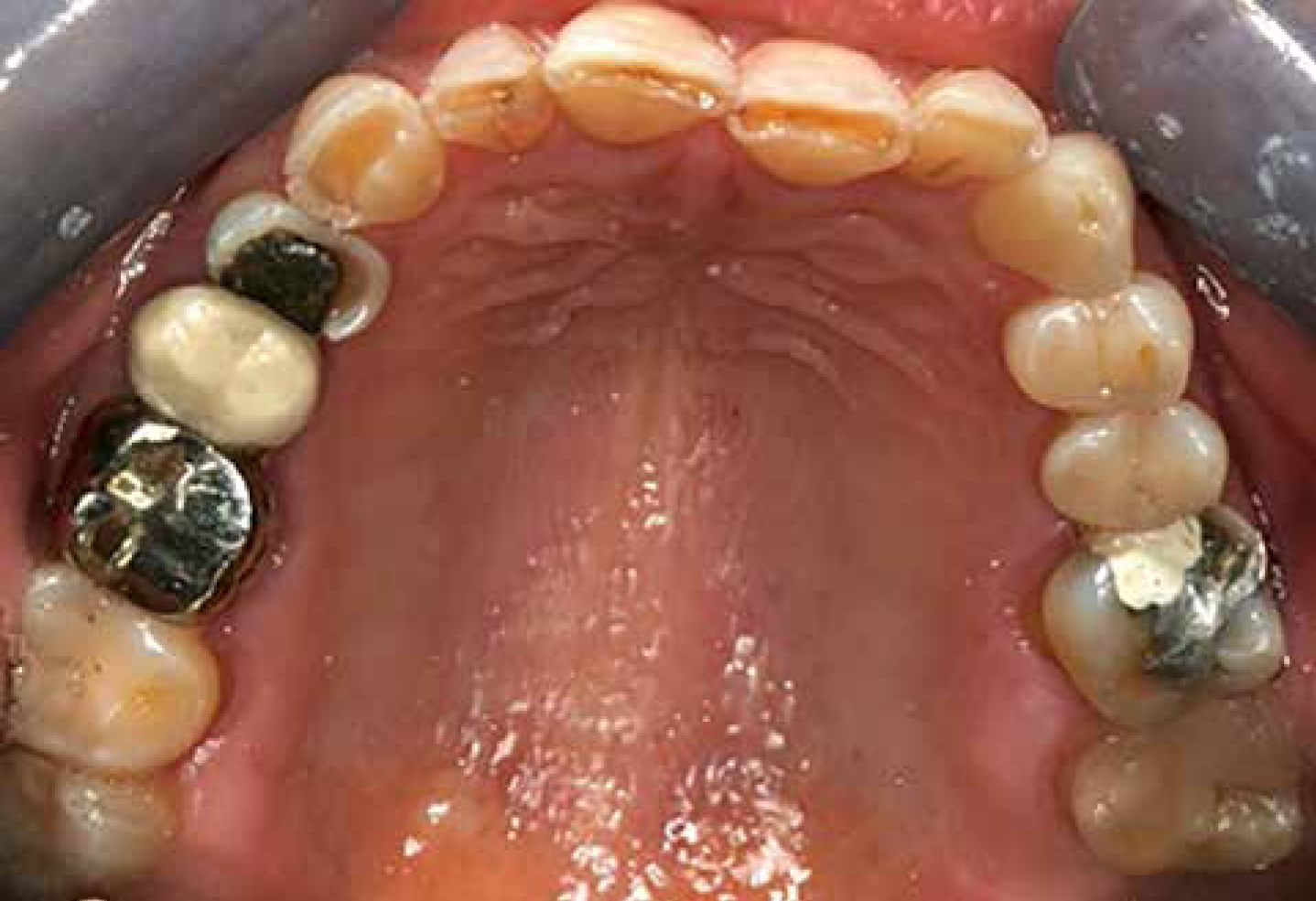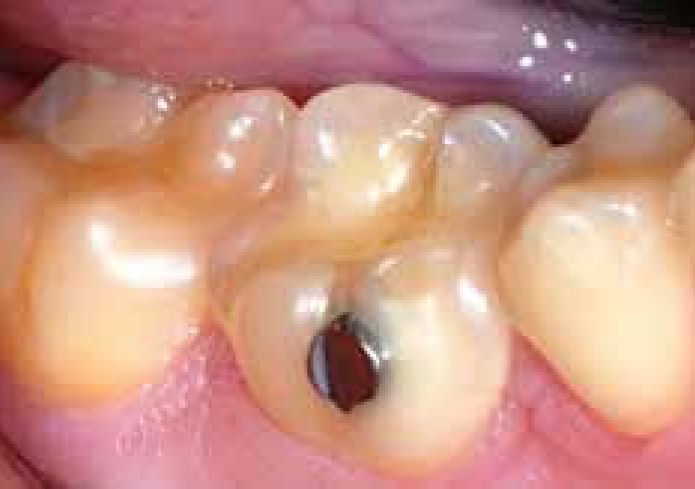References
The oral implications of mental health disorders part 1: eating disorders
From Volume 46, Issue 1, January 2019 | Pages 49-52
Article

Eating disorders
Eating disorders are a group of psychopathological conditions that are characterized by irrational eating behaviours. The unhealthy diet choices that are characteristic of the conditions are often adopted to control body weight and shape. The aetiology is thought to be multi-factorial in origin, arising from a combination of biological, psychological and social factors. Eating disorders can reduce quality of life by negatively influencing both physical and emotional well-being.1 In the UK it is currently estimated that up to 1.25 million people have an eating disorder of which 20% become chronically ill.2
The most prevalent eating disorders are anorexia nervosa, bulimia nervosa and binge eating disorder.2 Each of these conditions has associated oral symptoms, which can develop within six months of onset.1 This highlights the essential role that dental professionals have in recognizing the relevant oral signs and symptoms, thereby identifying individuals that may be suffering with an eating disorder. This may aid early diagnosis by appropriate referral to their medical practitioner to help manage the underlying condition. Table 1 summarizes the oral manifestations associated with these eating disorders.3
| Oral Findings | Anorexia | Bulimia | Binge Eating |
|---|---|---|---|
| Palatal tooth erosion | × | ✓ | × |
| Tooth sensitivity | × | ✓ | × |
| Xerostomia | ✓ | ✓ | ✓ |
| Dental caries | ✓ | ✓ | ✓ |
| Periodontal disease | × | ✓ | × |
| Enlarged parotid glands | ✓ | ✓ | × |
| Atrophic mucosa | ✓ | × | × |
| Poor oral hygiene | × | ✓ | × |
Anorexia nervosa
Anorexia nervosa (anorexia) presents as an unhealthy obsession with body image. Individuals with this condition experience a constant fear of weight gain and are unable to maintain a healthy body weight. They achieve their desired weight loss by significantly restricting food intake, resulting in being abnormally thin and lacking in energy.3,4 Nutritional deficiency is commonly experienced in those with anorexia due to the extreme limitation in calorie consumption.5,6
Mucosal lesions
Insufficient nutrition can affect the integrity of the oral mucosa, which can result in mucosal atrophy and increased susceptibility to oral ulceration.7,8 Vitamin and iron deficiency can cause inflammation of the lining of the oral cavity, glossitis and angular cheilitis.1,5,8,9 These patients are also at a higher risk of developing opportunistic infections, such as Candida, as a result of their restricted diet and experiencing xerostomia.1,8
Dental lesions
Individuals with anorexia frequently consume high levels of sugar in the form of confectionery and sweetened beverages. These are chosen to provide energy and to placate the feeling of hunger.4,8 The latter is also achieved by behavioural habits such as sucking citrus fruits.1,6,8 The high frequency and quantity of sugar and acid intake leads to high levels of caries and increased dental erosion.4,6 Dental caries can be extensive and may progress into episodes of dental pain.8 Tooth surface erosion due to anorexia often shows a characteristic pattern of tooth tissue loss involving the buccal and occlusal surfaces of posterior mandibular teeth (Figure 1).5

Periodontal lesions
The restrictive diet and high incidence of nutritional deficiency associated with eating disorders can influence the health of periodontal tissues. Micronutrient intake plays an important role in periodontal tissue maintenance, in particular establishing good alveolar bone density. Vitamin C also shares a significant relationship with periodontal diseases and is essential in maintaining and repairing the connective tissues. Scurvy, a deficiency in vitamin C, can lead to defective collagen formation due to disturbance in collagen synthesis.9 Scurvy is common among those suffering from anorexia and can result in gingivitis.1,8 Research suggests that those with anorexia have adequate oral hygiene, in comparison to the poorer oral hygiene exhibited in patients with bulimia nervosa.3
Salivary manifestations
Sialadenosis is frequently found in patients with eating disorders. It is a benign, non-inflammatory salivary gland enlargement.5,10 The parotid gland is predominantly affected, resulting in either unilateral or bilateral enlargement. Sialadenosis is thought to arise from peripheral autonomic neuropathy, which causes acinar enlargement and functional impairment such as reduced salivary flow.8
In addition, depleted serum calcium levels in saliva are common in patients with restricted dietary intake, resulting in reduced buffering capacity. This exacerbates the dental erosion and carious processes which already occur due to high sugar and acid intake, low saliva pH and decreased salivary flow rate.6,7
Anorexia has been suggested as a predisposing factor for necrotizing sialometaplasia. This is a rare, benign, necrotizing disease that is thought to result from an ischaemic event compromising the vascular blood supply to the salivary gland lobules. It involves the minor salivary glands, predominantly the mucoserous glands of the hard palate.11 Necrotizing sialometaplasia is a self-limiting disease but its deep ulceration shares resemblance with an invasive carcinoma, therefore careful recognition is essential to prevent misdiagnosis.1,8,11
Other oral manifestations
Xerostomia is often encountered by those with anorexia due to poor overall nutrition.7 Xerostomia is associated with a greater risk of caries formation.6 Xerostomia may also be associated with other oral symptoms such as burning mouth syndrome, an unpleasant taste, halitosis and ulceration.12 Burning sensations of the mouth can also be associated with nutritional deficiencies and mucosal atrophy.1
Bulimia nervosa
Bulimia nervosa (bulimia) is characterized by consuming large quantities of food followed by inappropriate compensatory methods, such as self-induced vomiting or use of strong laxatives to prevent weight gain. In order for a diagnosis to be made, this pattern of behaviour must occur at least twice a week for three months.1,4 The self-induced vomiting associated with bulimia appears to be one of the most destructive oral features of this condition as it has the potential to cause severe oral complications.
Mucosal lesions
Frequent vomiting can cause mucosal lesions, such as ulceration, to develop due to the direct contact of gastric acid on the oral mucosa.4 Erythematous lesions can arise from frictional trauma caused by inducing vomiting and usually develop on the soft palate and pharynx.8,13 Traumatic lesions can become secondarily infected by fungal infections.8 Lesions affecting the soft palate and pharynx should be a salient indicator of a possible patient with bulimia, as this presentation of trauma would be unlikely to result from normal healthy function. These patients may also exhibit accompanying extra-oral signs on their hands, including fingernail erosion or cuts and bruising on their knuckles, which result from teeth placing pressure on the skin whilst attempting to purge.7,13
Dental lesions
The acidic gastric contents that are expelled during vomiting come into contact with tooth tissue, leading to dental erosion; this is known as perimylolysis.13 Perimylolysis can often be detected clinically after patients have continued their binge eating and purging habits for at least two years.14 The strong acid exposure can cause the dentition to change shape, darken in colour and have a reduced clinical crown height. Teeth may also become weaker and more brittle as the structure changes. This can lead to increased fractures and chipping of incisal edges. In severe cases, the pulp may become exposed, leading to infection, discoloration or possibly pulp necrosis.4,7 There is often marked erosion of the palatal and incisal surfaces of the anterior maxillary teeth.5,6 The classic clinical presentation may be loss of enamel with rounded margins, a notched appearance on incisal surfaces and unrestored teeth losing natural anatomical contours. Existing restorations may resemble raised islands due to the loss of surrounding tooth tissue (Figure 2).13 Further tooth tissue loss may result if patients brush their teeth immediately after vomiting. The superficial enamel layers become soft following emesis and consequently toothbrushing or vigorous rinsing may cause hard tissue abrasion.4 The acid-induced erosion and abrasion of the hard tissues can result in dentine hypersensitivity to temperature and touch.8,13 Individuals suffering with bulimia tend to binge on carbohydrates, sweet foods and carbonated liquids. This frequent sugar intake can lead to extensive dental caries and additional tooth erosion.3

Periodontal lesions
The literature suggests that bulimia sufferers often have poor oral hygiene, however, the cause of this remains unclear.3,8 Poor oral hygiene seen in these patients could be related to reduced levels of self-care. Patients with poor oral hygiene will consequently have an increased risk of gingivitis and periodontitis.3,8 Patients with bulimia often have a diet of limited nutritional value, further enhancing the risk of developing periodontal problems, for example necrotizing periodontal diseases.9
Salivary manifestations
Bulimia can alter salivary composition, which leads to reduced salivary pH in bulimic patients.15 Additionally, there is a risk of hyposalivation, which can arise as a consequence of vomiting or as a side-effect of the medication used to treat bulimia.1,8 The combination of hyposalivation and reduced pH compromise the buffering capacity of the saliva. This will prevent neutralization of plaque-induced acid production, increasing the risk of caries and dental erosion.5 Necrotizing sialometaplasia may also be seen in patients with bulimia, with the same presentation as previously described for anorexia patients.8,11
Sialadenosis is a common finding in patients with bulimia, with a reported incidence of 10%−50%. The parotid gland is most often affected, producing a soft and painless swelling on palpation.10,14 The occurrence and extent of parotid gland enlargement is usually several days following a binge-purging episode. During the earlier stages of bulimia, sialadenosis tends to be intermittent and with time the swelling becomes more persistent, leading to a widened and square appearance of the mandible. This cosmetic deformity may compel the patient to seek treatment. Spontaneous regression of gland enlargement may occur with cessation of the purging habit.14
Other oral symptoms
A high incidence of xerostomia exists in patients with bulimia, with several different causes being proposed. Xerostomia is a common side-effect of self-medication with laxatives and diuretics, or from the medical management of bulimia using antidepressants, such as selective serotonin re-uptake inhibitors. Fasting and vomiting may also lead to chronic dehydration and subsequent xerostomia.14 Finally, the sensation of dry mouth may result from altered salivary composition, rather than an actual decrease in flow rate.15
Oral burning sensation is a complaint that some bulimic patients present with; this symptom is a possible sequelae of xerostomia.1,8 It is proposed that the aberrant eating patterns, unusual food choices and recurrent vomiting associated with bulimia could lead to hypoguesia.10 The taste impairment may also be the result of dietary trace metal deficiencies, in particular zinc.1,10
Binge eating disorder
Binge eating disorder is characterized as an individual that feels regularly compelled to overeat large amounts of food in a short space of time. The condition can affect men and women of any age, but onset is typically during late teens or early 20s. Symptoms include eating very fast, eating until you feel uncomfortably full, eating although you are not hungry, eating alone or secretly and feeling ashamed, guilty or depressed after binge eating.16
Dental lesions
The overeating in binge eating disorder has similarities to that which occurs in bulimia, but without the subsequent vomiting. Individuals with this condition consume a significant amount of food and drink that are high in sugar and acid.17 This diet can cause extensive dental caries and tooth erosion.8
Other oral symptoms
The management of binge eating disorders can involve the use of antidepressants, including selective serotonin re-uptake inhibitors.16 As previously indicated, xerostomia is a common side-effect associated with these medications, which may cause patients with binge eating disorder to experience dry mouth symptoms.4,16
Management in the dental setting
The multiple oral manifestations that are associated with each eating disorder discussed may occur very early following disease onset. Oral healthcare providers can often be the first medical professional to see patients with an eating disorder. They may attend as a routine recall patient or due to dental discomfort as a consequence of their eating disorder. Therefore, dental professionals are well placed to identify clinically unexplained oral symptoms and make a referral to our medical colleagues to allow early diagnosis and suitable management.8 Diagnosis by a medical practitioner is essential in ensuring that the underlying eating disorder is treated, before commencing dental management, in order to prevent recurrence of oral symptoms.
Dental professionals can provide advice regarding oral prophylaxis and diet to reduce plaque levels and minimize dental caries and erosion. As for all patients, customized oral hygiene instruction and dietary advice should be discussed. This includes advice regarding fluoridated toothpastes and consideration of further fluoridated supplements to help induce hard tissue remineralization. The use of desensitizing toothpaste may be indicated for patients experiencing dentine hypersensitivity. Patients should be encouraged to attend for regular oral examinations to monitor progress.1
Patients who have bulimia should be advised not to brush their teeth immediately before or after vomiting. The dental pellicle on the surface of teeth may provide some protection against the acid challenge, hence vomiting immediately after the pellicle is removed by brushing should be avoided. Immediately after teeth are exposed to gastric acid, the surface layers can become soft and more susceptible to abrasion, so brushing should be avoided. Patients should be instead instructed to rinse their mouth thoroughly with water or milk or to chew gum to decrease the acidity. In patients experiencing drug-induced xerostomia, substitute medications should be considered or the use of artificial saliva or sialagogue pastilles to help relieve symptoms.1
Dietary advice should include the avoidance of acidic, citrus and sugary food and drinks for all eating disorders. Patients with anorexia are likely to require specialist care from a dietitian and would benefit from regular intake of multivitamins and calcium supplements.1
Conclusion
Patients with established anorexia, bulimia or binge eating disorder are likely to experience oral manifestations that are associated with their condition.
This article highlights the need for general dental practitioners to become familiar with these oral signs and symptoms discussed to aid diagnosis and help in the management of these oral complications.

